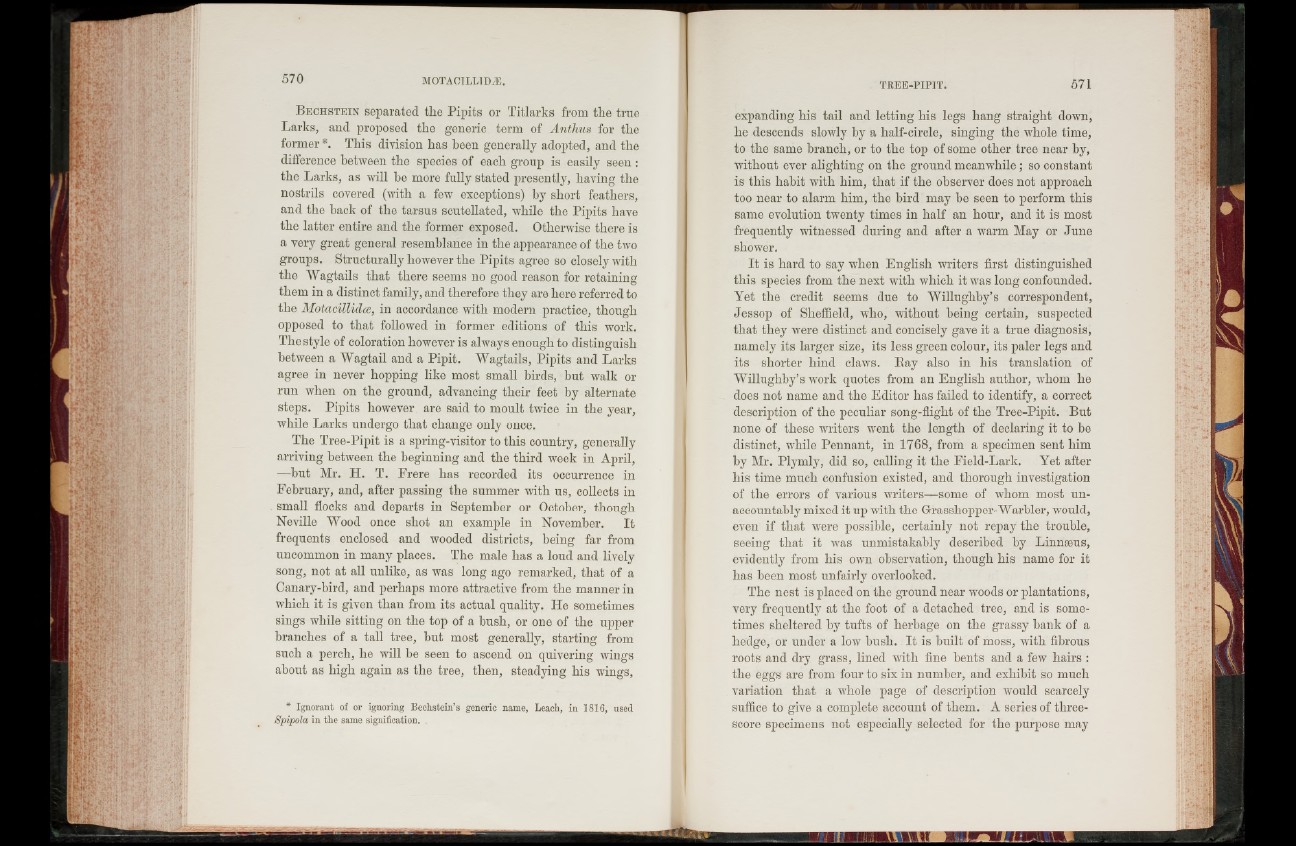
B e c h s t e in separated the Pipits or Titlarks from the true
Larks, and proposed the generic term of Antlius for the
former *. This division has been generally adopted, and the
difference between the species of each group is easily seen :
the Larks, as will he more fully stated presently, having the
nostrils covered (with a few exceptions) by short feathers,
and the back of the tarsus scutellated, while the Pipits have
the latter entire and the former exposed. Otherwise there is
a very great general resemblance in the appearance of the two
groups. Structurally however the Pipits agree so closely with
the Wagtails that there seems no good reason for retaining
them in a distinct family, and therefore they are here referred to
the Motacillidce, in accordance with modern practice, though
opposed to that followed in former editions of this work.
The style of coloration however is always enough to distinguish
between a Wagtail and a Pipit. Wagtails, Pipits and Larks
agree in never hopping like most small birds, but walk or
run when on the ground, advancing their feet by alternate
steps. Pipits however are said to moult twice in the year,
while Larks undergo that change only once.
The Tree-Pipit is a spring-visitor to this country, generally
arriving between the beginning and the third week in April,
—but Mr. H. T. Frere has recorded its occurrence in
February, and, after passing the summer with us, collects in
small flocks and departs in September or October, though
Neville Wood once shot an example in November. I t
frequents enclosed and wooded districts, being far from
uncommon in many places. The male has a loud and lively
song, not at all unlike, as was long ago remarked, that of a
Canary-bird, and perhaps more attractive from the manner in
which it is given than from its actual quality. He sometimes
sings while sitting on the top of a bush, or one of the upper
branches of a tall tree, hut most generally, starting from
such a perch, he will he seen to ascend on quivering wings
about as high again as the tree, then, steadying his wings,
* Ignorant of or ignoring Beehstein’s generic name, Leach, in 1816, used
Spipola in the same signification.
expanding his tail and letting his legs hang straight down,
he descends slowly by a half-circle, singing the whole time,
to the same branch, or to the top of some other tree near by,
without ever alighting on the ground meanwhile; so constant
is this habit with him, that if the observer does not approach
too near to alarm him, the bird may he seen to perform this
same evolution twenty times in half an hour, and it is most
frequently witnessed during and after a warm May or June
shower.
I t is hard to say when English writers first distinguished
this species from the next with which it was long confounded.
Yet the credit seems due to Willughby’s correspondent,
Jessop of Sheffield, who, without being certain, suspected
that they were distinct and concisely gave it a true diagnosis,
namely its larger size, its less green colour, its paler legs and
its shorter hind claws. Bay also in his translation of
Willughby’s work quotes from an English author, whom he
does not name and the Editor has failed to identify, a correct
description of the peculiar song-flight of the Tree-Pipit. But
none of these writers went the length of declaring it to he
distinct, while Pennant, in 1768, from a specimen sent him
by Mr. Plymly, did so, calling it the Field-Lark. Yet after
his time much confusion existed, and thorough investigation
of the errors of various writers—some of whom most unaccountably
mixed it up with the Grasshopper-Warbler, would,
even if that were possible, certainly not repay the trouble,
seeing that it was unmistakably described by Linnaeus,
evidently from his own observation, though his name for it
has been most unfairly overlooked.
The nest is placed on the ground near woods or plantations,
very frequently at the foot of a detached tree, and is sometimes
sheltered by tufts of herbage on the grassy bank of a
hedge, or under a low bush. I t is built of moss, with fibrous
roots and dry grass, lined with fine bents and a few hairs :
the eggs are from four to six in number, and exhibit so much
variation that a whole page of description would scarcely
suffice to give a complete account of them. A series of threescore
specimens not especially selected for the purpose may